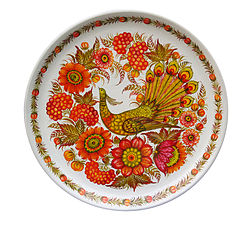A geographical indication (GI) is a form of intellectual property that identifies a product as originating from a specific geographical area as its qualities or reputation are tied to its origin. Such labeling guarantees that products sold under a specific name are authentic and meet defined standards, preventing imitation goods from entering the market. [1] [2] The protection of geographical indications was established under the Agreement on Trade-Related Aspects of Intellectual Property Rights, signed by members of the World Trade Organization (including Ukraine) on 14 April 1994 and effective from 1 January 1995. [3] [4] The Lisbon Agreement for the Protection of Appellations of Origin and their International Registration, signed on 31 October 1958, also introduced appellations of origin – a special category of geographical indications that denotes a particularly strong connection between the product and its area of origin. [a] [7] Unlike trademarks, geographical indications link a product's origin to a region rather than to a specific company. [8] Agricultural products are most often registered as GIs, since their characteristics are directly tied to local geographical factors such as climate and soil, although other products, including handicrafts, have received the status as well. [2]
Contents
The protection of geographical indications in Ukraine is regulated by the law "On Legal Protection of Geographical Indications" passed on 16 June 1999. [6] The law has undergone multiple amendments, particularly since 2019, aimed at aligning Ukraine's framework with European Union standards in preparation of the country's accession to the EU. [9] [10] As a result, Ukraine's geographical indications and appellation of origins are now analogous to the EU's Protected Geographical Indication (PGI) and Protected Designation of Origin (PDO) labels. [b] [11] Additional laws also outline the registration and protection of agricultural goods, foods, and spirits. [12] [14] The Ukrainian National Office for Intellectual Property and Innovations (IP Office) – the national authority responsible for intellectual property protection [15] – reviews GI applications, manages the national GI register, and coordinates international cooperation in the field. [c] [6] Applications – submitted by an association of producers, or by a single legal or natural person if they are the sole producer of the good – must detail a product's connections to the geographical area, its specific method of production, and its resulting unique qualities. The IP Office may declare a GI invalid if its registration violates the law or if a court determines that the production of the good has become impossible due to changes in the geographical area. [17] [18] Ukraine's legislation also protects numerous foreign geographical indications and appellations of origin, specifically those established by separate agreements with the European Union, [19] Georgia, [20] Italy, and Russia. [21] These items are not covered in this list as they do not originate in Ukraine.
As of October 2025, thirty items from Ukraine are listed on the country's Register of Geographical Indications, or 3,134 in total including foreign entries. Myrhorodska mineral water, Sonyachna Dolyna wine, and Skhidnytska mineral water were the first to enter the register on 15 March 2007. [13] On 11 November 2019, Hutsul sheep bryndzya became the first registered GI to meet the requirements of the European Union. [22] The most recent addition to the register is Frumushika steppe honey, registered on 3 September 2025. [13] Odesa and Zakarpattia oblasts (regions) are best represented in the register, largely due to the creation of wine and taste routes in Ukrainian Bessarabia and Zakarpattia – a culinary tourism initiative supported by the European Union. [23] [24] In addition, since the beginning of the Russo-Ukrainian war in 2014, Russia has appropriated a number of geographical indications originating in Ukraine's occupied territories, [d] registering them under its own national system. [30] [31] The European Union has banned the import of goods produced in these areas. [32] [33]




